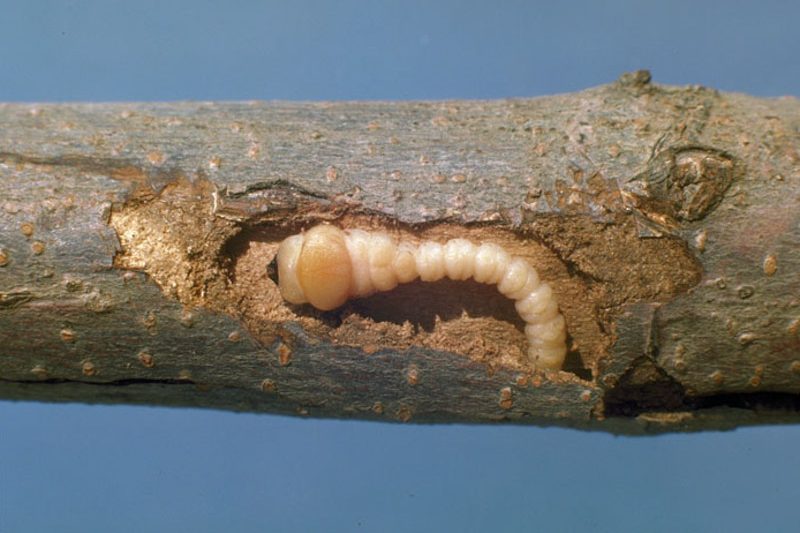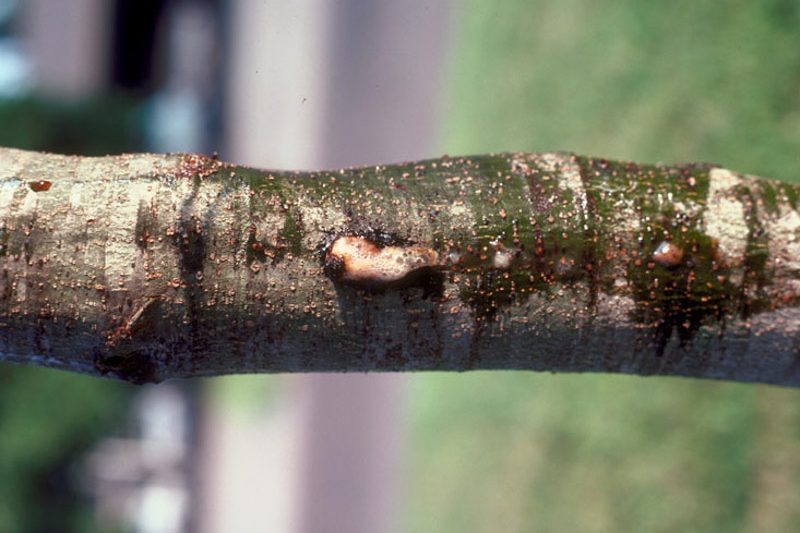Flatheaded Appletree Borers can be a significant problem, particularly for stressed or young trees.
The Flatheaded Appletree Borer (Chrysobothris femorata) is a wood-boring beetle that belongs to the family Buprestidae. While its name suggests it primarily targets apple trees, it is an opportunistic pest that can infest a wide range of deciduous trees.
Despite its name, the Flatheaded Appletree Borer (Chrysobothris femorata) is not limited to apple trees. This pest has a broad host range and can infest various deciduous trees and shrubs. Some of the host plants commonly affected include:
The Flatheaded Appletree Borer may also infest ornamental and landscape plants, including some varieties of roses and woody shrubs. The range of host plants increases the borer’s opportunity to find suitable habitats, making it a pest of concern for a wide variety of landscapes.
This borer is commonly found throughout most of Canada and the United States.
Adult beetles are metallic, shiny gray to brown, and approximately 12 to 18 mm long. They have a flattened body and a somewhat elongated shape. The larvae are quite distinctive; they are legless and have a cream to white body with a broad, flat head, which gives the insect its name. The larvae’s flattened anterior region allows them to carve out shallow tunnels beneath the bark of host trees, causing damage to the wood and overall tree health.
The life cycle of the Flatheaded Appletree Borer is a yearly cycle that encompasses four distinct stages: egg, larva, pupa, and adult.
Egg: The adult female beetle lays orange to reddish brown eggs in the crevices and cracks of tree bark, usually targeting weakened or stressed trees. Egg-laying generally occurs from late spring to early summer.
Larva: After hatching, the larva immediately begins to tunnel into the tree. It feeds on the cambial tissue between the bark and the wood, creating shallow, winding galleries filled with frass (a mixture of wood debris and excrement). The larval stage can last from several months to more than a year, depending on environmental conditions. It is during this phase that the most significant damage to the host tree occurs.
Pupa: When the larva has fully developed, it carves out a pupal chamber close to the surface of the bark. Inside this chamber, the larva transforms into a pupa. This stage generally takes place in late winter to early spring and lasts for a few weeks.
Adult: The adult emerges from the pupal chamber by chewing its way out of the bark, typically in late spring or early summer. The adults are relatively short-lived, surviving long enough to mate and lay eggs, thereby completing the life cycle.
This borer prefers weakened or stressed trees, meaning healthy trees are less likely to suffer severe infestations. However, if left unchecked, the flatheaded appletree borer can cause substantial damage, weakening trees and making them more susceptible to disease and other pests.

The Flatheaded Appletree Borer inflicts most of its damage during the larval stage. Larvae tunnel through the cambium layer, feeding on the nutrient-rich tissues between the bark and wood. These tunnels disrupt the tree’s ability to transport nutrients and water, thereby weakening it significantly. Over time, these feeding galleries can girdle a tree, potentially leading to its death.
The damage is often most apparent at the base of the trunk but can occur higher up as well. Sunken, discolored patches on the bark or oozing sap may also indicate an infestation. The holes created when adults emerge are another visible sign, usually about 1/8 to 1/4 inch in diameter. Severely infested trees may display general symptoms of decline like branch dieback, stunted growth, or increased susceptibility to diseases.
Early detection is crucial for effective management. Here are some methods to detect an infestation:

Controlling the Flatheaded Appletree Borer requires a multi-pronged approach that includes cultural, mechanical, and chemical methods. Here are some strategies:
Regularly inspect your trees for signs of borer activity. This could include:
Prevention is always the best control method, so keep your trees healthy, monitor them regularly, and apply treatments as necessary.
Create a membership account to save your garden designs and to view them on any device.
Becoming a contributing member of Gardenia is easy and can be done in just a few minutes. If you provide us with your name, email address and the payment of a modest $25 annual membership fee, you will become a full member, enabling you to design and save up to 25 of your garden design ideas.
Join now and start creating your dream garden!
Create a membership account to save your garden designs and to view them on any device.
Becoming a contributing member of Gardenia is easy and can be done in just a few minutes. If you provide us with your name, email address and the payment of a modest $25 annual membership fee, you will become a full member, enabling you to design and save up to 25 of your garden design ideas.
Join now and start creating your dream garden!